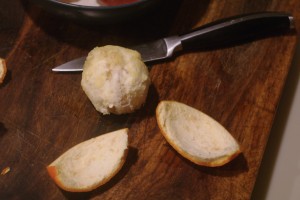Aunt Gin-ny's Marmalade
All photos by Chris Wertz.
I’ve been drinking a lot of gin lately. I have to - it’s part of my job. In the process of writing the upcoming book Brooklyn Spirits: Craft Cocktails and Stories from the World’s Hippest Borough, I have had to become intimate with all things “gin” coming out of Brooklyn, which at this point numbers 9 varieties! So when February rolled around and I saw those Seville Sour Oranges on the store shelves, my mind went to one thing: gin-flavored marmalade. This is a straightforward marmalade recipe that is flavored with botanicals commonly found in gin - especially a great deal of juniper. Citrus has long been a close friend of gin, so this match is a perfect fit?
What you will need:
- 3 Seville Sour Oranges
- 1 Navel Orange
- 1 Meyer Lemon
- 1 kilogram Sugar
- 1.25 liter Water
Gin Botanicals:
- 1 Tbs. Juniper
- 1 tsp. Elderberry
- 1/2 tsp. Elderflower
- 1 tsp. Chamomile
- 1 tsp. Cinnamon
(Editor's note: these items can often be found in loose teas at a good spice store.)
First, peel the fruit by scoring the skin and removing it in petals. Good marmalade is bitter, so there is no need to scrape off the white pith from the peel. Next, slice the peels into very thin segments, about an half inch long, and put them in a pot big enough to hold all of the ingredients. Juice all of the fruit being careful to save the seeds. I squeeze them over a strainer into the pot. Once all of the fruit is juiced and all of the seeds are removed, chop up the remaining fruit pulp and add it to pot. Collect the seeds in cheesecloth or a tea ball, something that will allow you to extract the pectin from them, but not leave them floating in your jelly jars later. Pectin is a natural gelling agent that is especially rich in citrus fruits. So there’s no need to add any pectin to this recipe. Add the water and the seed bundle to the mix and wait. There are lots of versions of what to do next. I took my approach from The Wednesday Chef who suggested soaking the peels for a full 24 hours to soften them.
The next day, tie the gin botanicals together in cheesecloth or another tea ball of you have it and place them in the pot. Bring the whole mix to a boil and simmer for 45 minutes.
***
This is a good time to pour yourself a drink. Maybe one with marmalade? Preferably one made with a local gin. While you’re waiting, drink in hand, check out a brief history of gin here:
***
After simmering for 45 minutes, remove the seeds and botanicals from the pot.
Add the sugar and simmer again for 30 minutes to an hour or until your marmalade reaches 220° F on a candy thermometer. If you do not have a thermometer, after 20 minutes, dip a cold spoon into the pot and let the marmalade run off the spoon. The first time you test it, it will drip off the spoon like a loose liquid. When it oozes off the spoon in one glob without dripping, it’s done. (Read here for more information on testing the doneness of jam.)
Fill jars to the brim and store in your fridge upside down for up to a year.
The marmalade you made is bitter, fragrant, sweet and sour. The gin botanicals add a complexity beyond the astringency of the juniper. There should be notes of spice, berries, flowers and pine. The peels should be spreadable, but still slightly firm and chewy. Slather it on bread with fresh butter or mascarpone or even use it to glaze chicken or ham. You can even mix it with soy sauce and vinegar to make a kick-ass sweet and sour sauce for dipping.
There are plenty of ways you can play with this recipe: You can use more or less sugar. Substitute some of the fruit, like a blood orange for the navel orange for a darker, sweeter marmalade. As for the botanicals, use whatever you have: coriander, rose petals, chili peppers, anise, cardamom and nutmeg all work great. Many gins list their botanicals, so you can have fun mimicking your favorite bottle.
The newer gins are setting themselves apart from the established brands by being more expressive of their botanical mix. Of the many in New York City, Brooklyn Gin has strong notes of kumquat and juniper. Greenhook Ginsmiths uses floral elements like chamomile and elderflower. The Dorothy Parker gin from New York Distilling Co. has dried hibiscus petals. And the Glorious Gin from Breuckelen Distilling has strong notes of grapefruit. Your ginned-up marmalade can go in any direction at all.
If you missed the boat on the Seville Oranges, don’t fret. You can make marmalade with any oranges or grapefruit or even pomelo for that matter. Just be sure to maintain the ratios of sugar to fruit. [The above recipe uses about 700 g of citrus.] Like the new gins on the market, your marmalade should be an original expression.




